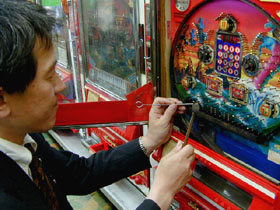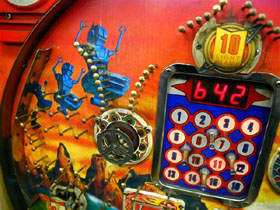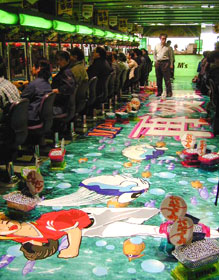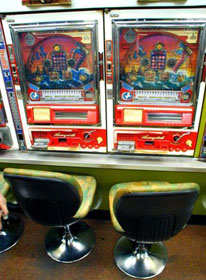A Pachinko Parlor Owner Sticks to His Nails
A few pachinko balls - remnants of yesterday's "research" - spill from Captain Japan's pockets as he tumbles from the cab near Ichigaya Station on a recent weekday morning. The pachinko story deadline is today. No problem, he thinks, that is why they invented tomorrow.
 He shakes the dust from his jacket - and last night's whiskey from his vision - and approaches the building lobby. In a move he has perfected over the years, he swaps "yesterday's" necktie for "today's" while inside the elevator. As the elevator doors part on the newsroom floor, junior reporter Junko stands waiting, hands on hips. Tomorrow has just become today.
He shakes the dust from his jacket - and last night's whiskey from his vision - and approaches the building lobby. In a move he has perfected over the years, he swaps "yesterday's" necktie for "today's" while inside the elevator. As the elevator doors part on the newsroom floor, junior reporter Junko stands waiting, hands on hips. Tomorrow has just become today.
Yoshimasa Ono puts the compilation cassette into the stereo underneath his counter. It is a mix of oldies ("I've Got Rhythm") and new artists (Mariah Carey). Just behind him in a glass cabinet are packages of soap and corned beef. It is mid-morning and his regulars are just now beginning to take their seats in one of the four rows of machines at Kamome, his small pachinko parlor near Tokyo's Yurakucho Station.
Ono's machines, all roughly 20 years old, are quite a bit different from the typical machines found today in Japan's parlors. They are relative antiques.
"Inside the machines, the parts are old. I feel like they are my children," says Ono, manager of the shop for the last 10 years.
The outsides too. Spaceships, robots, and horses are painted onto the playing surfaces amid a smoky mix of blue and red. LED readouts and light-up numbered dots indicate the player's progress. This is quite a contrast from the computer driven components and displays that are standard today.
The furnishings of his parlor, opened in 1951 by his father, likewise have managed to halt the march of time. The chairs look like they have borrowed their mix of green and yellow colors from a Monet landscape. His wallpaper might be better suited for wrapping wedding gifts. But this is how he wants it. The uniqueness of his "classic" machines and his parlor is Ono's main selling point.
 Ono believes there to be only two other parlors in all of Tokyo operating under the same blast-from-the-past aesthetic that he is. That is because a slowing Japanese economy has been recently forcing Japan's entire pachinko industry to focus on new advances in pachinko machine technology and modern facilities to lure an ever-decreasing pool of players. As a whole, the industry is trying to improve its image. Where pachinko parlors were once something that attracted the middle-aged chain-smoking male (Ono's average regular), they now are trying to be hip and happening. As a result, Ono, his machines, and his parlor, are a holdover in Japan, a dying breed.
Ono believes there to be only two other parlors in all of Tokyo operating under the same blast-from-the-past aesthetic that he is. That is because a slowing Japanese economy has been recently forcing Japan's entire pachinko industry to focus on new advances in pachinko machine technology and modern facilities to lure an ever-decreasing pool of players. As a whole, the industry is trying to improve its image. Where pachinko parlors were once something that attracted the middle-aged chain-smoking male (Ono's average regular), they now are trying to be hip and happening. As a result, Ono, his machines, and his parlor, are a holdover in Japan, a dying breed.
"Lately all the machines are automatic. A player doesn't have to use his hands as much to control the speed of the balls entering the top," laments Ono.
The pachinko machine is like an upright pinball machine consisting of rows of nails and gates. Balls are pooled in a tray at the bottom and, under the control of a hand-operated dial, shot to the top, from where they trickle down. Those finding their way around the pins and into selected gates are returned to the player with a bonus payout of more balls, perhaps thousands of balls.
The origins of the game date back to a horizontal board game imported by an Osaka company from the United States in 1924. Even though the pachinko industry's annual sales are down 6 percent from its peak in 1994, they still amount to 30 trillion yen, making it larger than the domestic auto industry. Thus, the future of the dancing steel balls is serious business.
In Tokyo's fashionable Shibuya district sits a model of pachinko's future - the Maruhan Pachinko Tower. Over 500 machines stand at the ready to challenge any of the over 5,000 daily players.
 Maruhan's biggest draws are its new machine events. Ten machines are added for each event with each machine being replaced roughly every 6 months. The machines always are of rimmed with colorful plastic and feature the latest in computer technology. LCD displays set into the machines often show animations of popular cartoon characters or TV stars. TV personality Akiko Wada was featured, and so was Godzilla. In Maruhan, players can be seen watching the afternoon news on personal TV screens mounted into the machine console to the left of the tumbling balls.
Maruhan's biggest draws are its new machine events. Ten machines are added for each event with each machine being replaced roughly every 6 months. The machines always are of rimmed with colorful plastic and feature the latest in computer technology. LCD displays set into the machines often show animations of popular cartoon characters or TV stars. TV personality Akiko Wada was featured, and so was Godzilla. In Maruhan, players can be seen watching the afternoon news on personal TV screens mounted into the machine console to the left of the tumbling balls.
The changes that have taken place, however, only begin with the machines. With their relatively large disposable incomes and free time, women and younger people are increasingly being targeted by the industry. As a draw, brand name goods are now being used as prizes in some parlors. The need for prizes is a holdover from the past. Converting the balls directly to cash on the pachinko premises would constitute gambling, and be illegal under Japanese law. Thus, the balls are exchanged for various goods or tokens. Selected goods and the tokens can then be swapped to cash at a shop - keihin kokanjo - conveniently located near the parlor. In days gone past, candy and cigarettes were common prizes. Today, Maruhan offers Swiss Army knives, Fendi handbags, and compact vacuums. In contrast, Ono gives soap and corned beef. It is not difficult then to see why he describes his recent business as being "tough."
Additionally, some parlors are providing bars, cafes and women-only sections for the discriminating player. Even lounges with fancy hotel lobby-like furnishings are being tried.
Maruhan pulls no punches in its attempts to lure players with amenities. Riding the escalator up to the second floor of Maruhan is like entering the belly of spaceship poised for takeoff. The patter of the balls is rapid and deafening. The interior is painted in gray and the room fixtures are smooth and metallic. The floor comes alive through dozens of cartoon character drawings. Above, an elaborate air filtration system hisses amid the few pulses of dance music that manage to penetrate the sound of the rattling balls. Snack stands, vending machines, and storage lockers are all on offer.
But even with the technological advances of the new pachinko machines, one rudimentary aspect of the business still does remain: the "tuning" of the nails. Selected nails, crucial to directing the balls to payoff gates, are slightly bent one way or the other by the parlor owners in the night when the parlors are closed. The process is technically illegal.
 This skill is Ono's bread and butter. In being the owner of a business and a father of three, controlling which machines pay out a lot and which pay out a little is necessary for him to stay in business. The last thing he wants to do is actually gamble with his customers. Thus, his talent as a kugishi - or nail specialist - with a hammer is as important as paying the electric bill.
This skill is Ono's bread and butter. In being the owner of a business and a father of three, controlling which machines pay out a lot and which pay out a little is necessary for him to stay in business. The last thing he wants to do is actually gamble with his customers. Thus, his talent as a kugishi - or nail specialist - with a hammer is as important as paying the electric bill.
"I adjust the machines once every two months," he says of the practice. "The players don't know clearly which machines are being adjusted."
Of course, players always have numerous theories on when and to which machines adjustments are being made. Shrewd players then will line up hours before a parlor's opening in hopes of getting a machine that they predict to be hot.
But Ono's nail tapping days might soon be over. The block in which his parlor sits is due to be torn down next year in favor of a high-rise. He will try to find a new location. "But if I cannot find a new spot, I will have to retire," he says.
In the meantime, Ono says he will continue greeting his regulars with a smile and small conversation, a simple way to keep the customers happy. But the machines are the priority, he assures. "My customers have developed personal relationships with the machines. At the new places, everything is so fast. Nobody can relax. Here, they can play slowly at their own pace."
Note: Eric Prideaux contributed to this report.

